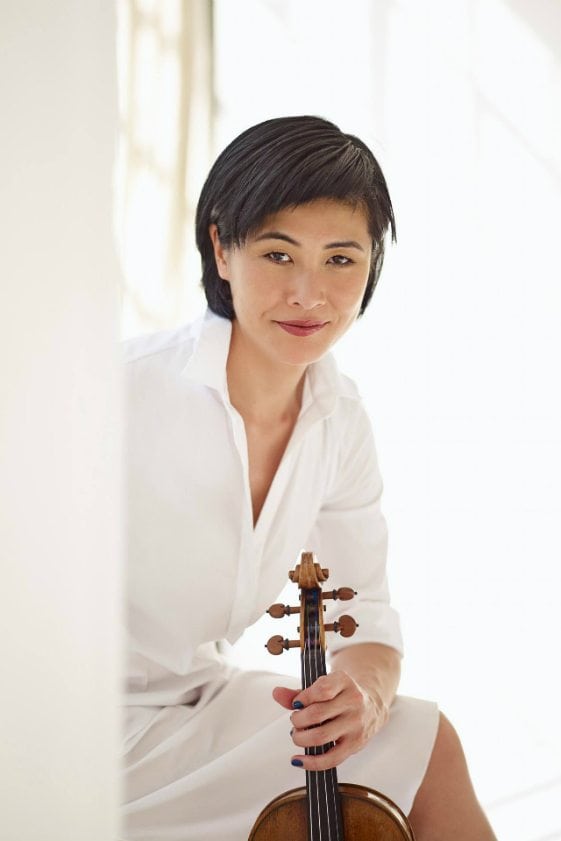Eschenbach, Koh and Houston Symphony achieve liftoff in Salonen, Bruckner

Jennifer Koh performed Esa-Pekka Salonen’s Violin Concerto with Christoph Eschenbach and the Houston Symphony Thursday night at Jones Hall.
Twenty years have passed since Christoph Eschenbach stepped down as the Houston Symphony’s music director, ending an 11-season collaboration that won the orchestra an international standing through tours and recordings. Fortunately, the orchestra brings their former chief back regularly for guest appearances. Thursday night at Jones Hall Eschenbach offered a pair of sonic blockbusters by Anton Bruckner and Esa-Pekka Salonen.
The concerto genre may not ordinarily land in that category, but Esa-Pekka Salonen’s Violin Concerto easily qualifies, calling for virtuosic brilliance and full-throttle energy from the orchestra as much as the soloist.
Leila Josefowicz, who premiered the concerto in 2009 and has championed it ever since, bowed out because of illness. But the orchestra was able to enlist the concerto’s other main advocate, violinist Jennifer Koh, to take over.
In the first movement (“Mirage”), a perpetual-motion solo sprint collides with an orchestral outburst, then the violin part grows even more intense from there. The second movement is a reverie that requires delicacy and concentration; the third unleashes machine-gun force from both soloist and orchestra. And in the finale, (“Adieu”), the solo line ranges more widely than any human voice could encompass, but it comes alive only if a violinist can spin it out with a singer’s fervor and lyricism.
Koh was fully up to the concerto’s fearsome demands, capturing its ferocity as well as its inwardness. She made the opening light and fleet, as it she were capturing the music on the wing. After the first orchestral salvo, when the solo part began working in broader strokes at times, she injected the music with boldness and fire.
The second movement’s brooding came across through Koh’s half-shades and gently sketched lines. She attacked the third movement’s salvos of chords with unstinting vigor and unabashedly fierce tone. And in the finale, Koh spun out the violin’s flights of lyricism with vibrant coloring, conviction and finesse.
Eschenbach and the orchestra added their own color and drama. If the orchestra’s growling sonorities were the counterpoint to the violin’s velocity in the first movement, Eschenbach helped shape the murmurs and glimmers that created the second movement’s stillness.
In the third movement, which Salonen’s program note calls “bizarre and urban,” the orchestra’s walloping force redoubled Koh’s impact, and the woodwinds cried out with particular abandon. A rich-voiced and expansive English horn solo helped set the finale’s tone. Eschenbach leadership of the orchestra complemented Koh’s lyricism with its own, and at times seemed to well up around her.

Christoph Eschenbach
Anton Bruckner’s Symphony No. 4 offers more conventionally comfortable harmonies. But Eschenbach and the orchestra made its mountain-peak climaxes eclipse even Salonen’s outbursts in terms of power.
Time and again, the orchestra produced groundswells of rich, resounding tone. The brasses welled up commandingly, but they remained rich, gleaming and well-blended, never raw. The rest of the orchestra added fullness and vibrancy.
Sometimes Eschenbach guided the group through long buildups that ultimately delivered the electricity of arriving at a summit. Sometimes, especially in the finale’s unison outcries, the orchestra’s full power crashed in on silence. All those moments gained part of their electricity from the fact that Eschenbach created such a rich, broad sonic landscape around them.
Though he gave each movement an underlying momentum that helped the hour-plus work hold together, he still brought out nuances that revealed the work’s eloquence and poetry. The country-dance episodes in the first and last movements had a crispness and buoyancy that helped balance out the symphony’s grandeur. In the slow movement, Eschenbach let the melodies flow, but he also allowed the players to savor their most expressive passages. When the violas took the spotlight, he guided them as they sang out their melody–swelling here, whispering there, making each phrase poetic.
The orchestra put vigor and swagger into the scherzo, aside from a few misfired notes from the brasses. But Eschenbach also brought out the middle section’s coziness and lilt.
And throughout the symphony, the players enriched the music with vivid details—as when Echenbach spurred the second violins to bring out their spirited crossplay while the first violins had the lead.
One of the most arresting moments came after the thunderous climax at the center of the first movement. Eschenbach had the strings reply by caressing the melody in their softest, most glowing tones–showing that Bruckner was about tenderness as much as fortissimos.
The Houston Symphony will repeat the program 8 p.m. Saturday and 2:30 p.m. Sunday in Jones Hall. houstonsymphony.org; 713-224-7575.